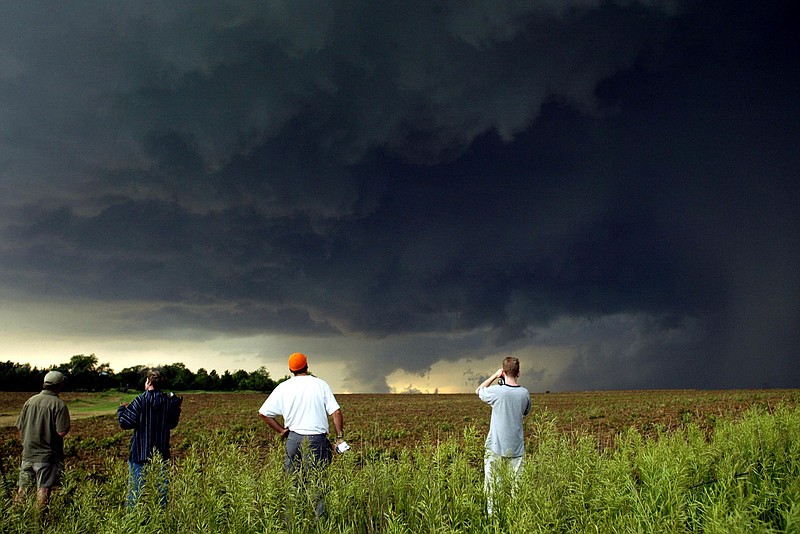Over the past 40 years, tornado activity has increased by about 10% in the mid-South and decreased by the same amount in the Texas panhandle through southwestern Kansas, said Harold Brooks, a senior research scientist with the National Severe Storms Laboratory in Norman, Okla.
But that doesn't mean the traditional "tornado alley" is shifting to the east, he said.
"The notion of alleys are not well defined," said Brooks. "And if you use the same definition the whole time, it's really hard to say it's moved."
Arkansas, he said, is somewhat in between these tornado hot spots, with Little Rock on the western edge of the one in the mid-South.
The South historically has had a lot of tornadoes, said Brooks.
In the 1920s and '30s, more tornadoes hit Louisiana, Mississippi and Alabama than the "tornado alley" of the Plains states, he said.
Tornadoes in Arkansas and the southeast occur year-round and at all hours, said Brooks. In the Plains states, the vast majority of tornadoes occur in the late spring and not late at night.
"Seventy-five percent of the tornadoes within 100 miles of Oklahoma City are on the ground between 5 and 9 p.m.," he said. "Overnight stuff doesn't happen here very much."
Because there are hills and trees in Arkansas and the southeastern United States, it means there's less chance of seeing a tornado coming, especially if it's the middle of the night. And there are more mobile homes in this part of the country, which can be rolled by strong winds.
That has earned the area the ominous nickname of "tornado fatality alley," said John Lewis, a senior meteorologist with the National Weather Service in North Little Rock.
"By the time you see it, the tornado's on top of you," he said. "We have had our share of pretty big outbreaks here in the last 10 years in this part of the country. Big outbreaks, a lot of fatalities, and it seems to be away from where you normally hear about, you know, where the tornadoes should be, at least the biggest tornadoes."
On March 31, EF3 tornadoes with maximum winds of 165 miles per hour killed four people in Wynne and one in North Little Rock.
Lewis includes Arkansas in his definition of "tornado fatality alley," a term that was coined by Walker Ashley, a distinguished professor at Northern Illinois University. The South's tornado zone is also known as "Dixie alley."
The National Weather Service monitors tornado activity based on overlapping 30-year time periods.
Lewis said the number of tornadoes reported in Arkansas increased from an annual average of 33 to 37 from the 1981-2010 monitoring period to 1991-2020.
"Some of that is due to detection," he said.
The Weather Service in Arkansas got Doppler WSR 88-D radar in the early 1990s, and the number of reported tornadoes in the state doubled from 19 pre-Doppler to 39 since then.
The radar was able to detect many smaller tornadoes that might otherwise have gone unnoticed. Lewis said 90% of all tornadoes are rated either EF0 or EF1, meaning wind speeds between 65 and 110 miles per hour.
"A lot of these tornadoes that are being counted are zeros and ones that we just didn't see before," he said.
Most tornadoes still occur in the Plains.
"If you look at the number of tornadoes around the country, the biggest numbers are still, in the last 30 years, out in the plains," said Lewis. "So, Texas gets about 139 tornadoes a year, Kansas gets about 84 and Oklahoma gets 66. So those are still the biggest numbers in the country.
"Not far behind, though, you've got Alabama and Mississippi in the 50 range. Illinois is kind of up there at 54."
Lewis said a decrease in tornado activity in the Plains states over the past few years could be caused by drought.
"Yes, there have been more tornadoes over the southeast and maybe less over the plains because there's been a lot of drought recently," he said. "But to say it's shifted forever, it may be a little premature to say that.
"There may be a shift going on. My question is, is it permanent? Only time will tell."
During La Nina weather patterns, when Pacific Ocean water near the equator is cooler than it should be, tornado outbreaks in the southeast seem to be more frequent and can happen earlier in the year than usual, said Lewis.
In Arkansas, March through May is the traditional severe weather season, but during a La Nina cycle, the severe weather season can start here as early as January, he said.
"Some of the larger tornado outbreaks we've had here in Arkansas have happened during La Nina years," said Lewis. "The three biggest tornado years in Arkansas on record were La Nina years."
Those record years occurred when Arkansas got 107 tornadoes in 1999, 81 in 2008 and 75 in 2011.
Brooks said the process of taking tornado reports has changed over time, and some places may keep better track of tornado reports than others.
"We probably miss fewer tornadoes now than we did in the 1960s, everywhere, or almost everywhere," he said. "But another thing, there may be different quality of [those] databases in different parts of the country."
Brooks said he "wouldn't be surprised" if global warming caused the 10% shift in tornado activity in the Plains and the mid-South but it's not possible to draw that conclusion at this point.

